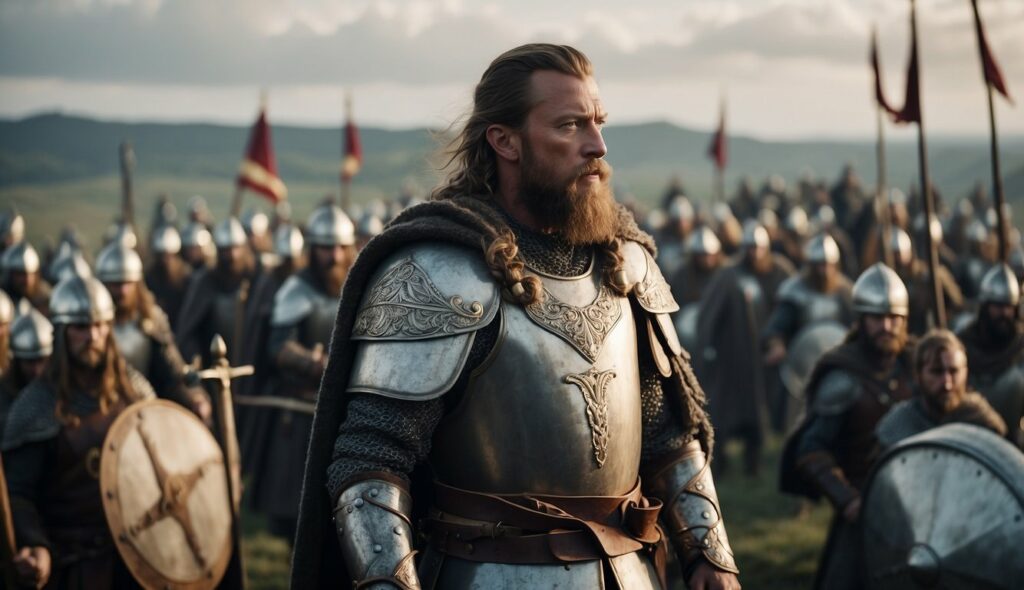Harald Hardrada, also known as Harald Sigurdsson III, was the last great Viking king of Norway.
He was born in 1015 in Ringerike, Norway, and led a life of adventure and conquest that would eventually lead him to attempt to seize the English throne in 1066.
The story of Harald Hardrada is an epic tale of adventure, conquest, and tragedy. His life was marked by his many military campaigns, including his invasion of England in 1066, which would ultimately lead to his downfall.
Despite his many victories and accomplishments, Hardrada is perhaps best remembered as the last Viking king, a title that has earned him a place in history as one of the most legendary figures of the Viking Age.
The Last Viking: The True Story of King Harald Hardrada is a fascinating look at the life and legacy of one of history’s most iconic figures. From his early days as a young warrior to his final battle at Stamford Bridge, this book tells the story of a man who lived and died by the sword, and whose legacy lives on to this day.
Early Life and Rise to Power

Harald Sigurdsson, better known as Harald Hardrada, was born in 1015 in Ringerike, Norway, and was the son of Sigurd Syr, a Norwegian chieftain.
Youth and Exile
Harald became a Viking warrior at the young age of 15 and quickly rose through the ranks to become one of the most feared and respected warriors of his time.
His youth was marked by his involvement in the Battle of Stiklestad, where he fought alongside his half-brother, King Olaf II. However, after Olaf’s death, Harald went into exile and joined the Varangian Guard in Constantinople.
Service in the Varangian Guard
Harald’s time in Constantinople proved to be a formative experience for him, as he gained valuable military experience and developed a reputation as a skilled warrior.
He served in the Varangian Guard for several years, rising through the ranks and eventually becoming the leader of the elite unit.
During his time in the Guard, Harald fought in several battles and gained a reputation as a fearsome warrior. He also developed a close relationship with Emperor Michael IV, who trusted Harald and relied on him for military advice.
Return to Scandinavia and Claim to the Throne
In 1046, Harald returned to Scandinavia and claimed the Norwegian throne, which was then held by Magnus the Good.
Harald’s claim was based on his descent from King Harald Fairhair, who had united Norway in the 9th century.
Harald’s claim was initially rejected by Magnus, but Harald eventually gained the support of the Norwegian nobility and was crowned king in 1047.
Harald’s reign was marked by his military campaigns, which included an unsuccessful invasion of Denmark and a successful campaign against Sweden.
Harald also maintained close ties with the Byzantine Empire, and his reign saw an increase in trade between Norway and the Byzantine Empire.
Reign and Achievements

Consolidation of Power in Norway
Harald Hardrada, also known as Harald III, ascended to the Norwegian throne in 1046 after the death of his nephew Magnus, consolidating his power over the country.
He was known for his military prowess and his ability to defeat his enemies in battle.
Harald’s reign was marked by his efforts to centralize power in Norway and establish a strong monarchy. He implemented a system of taxation and built a network of roads to improve communication and trade within the country.
Conflicts and Alliances
Harald III was not content with just ruling over Norway and sought to expand his influence beyond its borders.
He launched a series of successful military campaigns against Denmark and Sweden, and formed alliances with other Scandinavian countries to create a powerful North Sea Empire.
However, he also faced setbacks, including a failed invasion of England in 1066, which ultimately led to his death.
Cultural and Economic Progress
Harald III’s reign saw significant cultural and economic progress in Norway.
He was a patron of the arts and encouraged the development of literature and poetry.
He also promoted trade and commerce, which led to increased prosperity for the people of Norway.
Harald’s legacy as a great Norwegian king is still celebrated today, and he is remembered as one of the last great Viking rulers.
The Conquest of England

Invasion Plans and Initial Battles
Harald Hardrada’s ambition to claim the English throne led to the invasion of England in 1066, a year that would change the course of history. This section covers the invasion plans, initial battles, and the Battle of Stamford Bridge.
Harald Hardrada, with the support of Harold Godwinson’s brother Tostig, planned to invade England with a fleet of 300 ships and an army of 15,000 men.
The invasion force landed in northern England on September 20, 1066, and quickly defeated the local Anglo-Saxon forces at the Battle of Fulford.
However, Harold Godwinson, who had just been crowned King of England, quickly marched his army north to meet the invaders.
The two armies clashed at the Battle of Stamford Bridge on September 25, 1066.
The Battle of Stamford Bridge
The Battle of Stamford Bridge was a brutal and bloody affair that lasted for several hours. The Viking army fought fiercely, but the Anglo-Saxon forces were able to hold their ground and ultimately emerged victorious. Harald Hardrada and Tostig were both killed in the battle, and the Viking army was defeated.
The Battle of Stamford Bridge was a significant victory for the Anglo-Saxons, but it also left them weakened and vulnerable. Just a few days later, they would face another invasion force led by William the Conqueror. This would culminate in the Battle of Hastings and the Norman Conquest of England.
Despite his defeat, Harald Hardrada’s legacy as the last great Viking king lives on. His audacious invasion of England and his epic battle at Stamford Bridge are remembered as some of the most dramatic events of the medieval period.










Add Comment